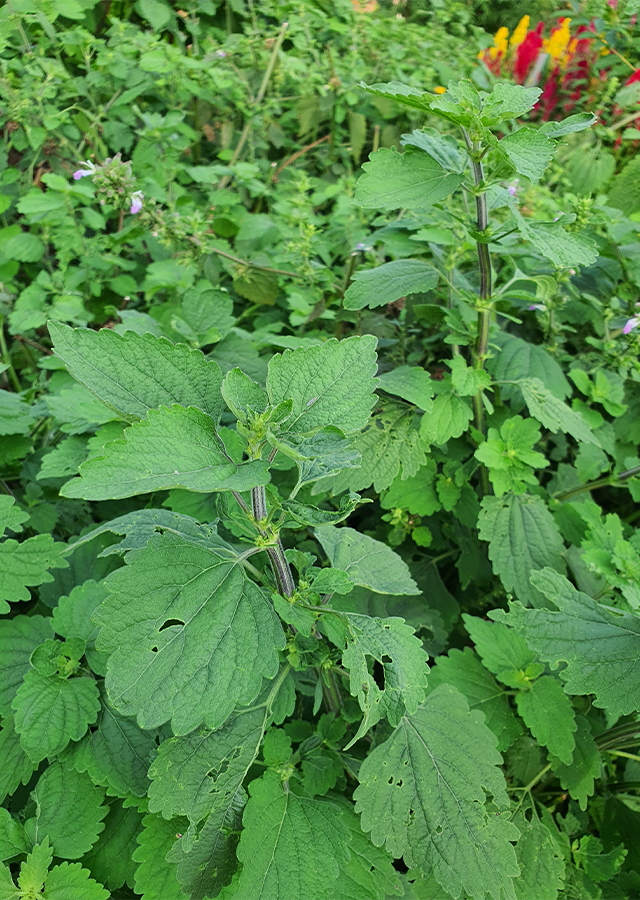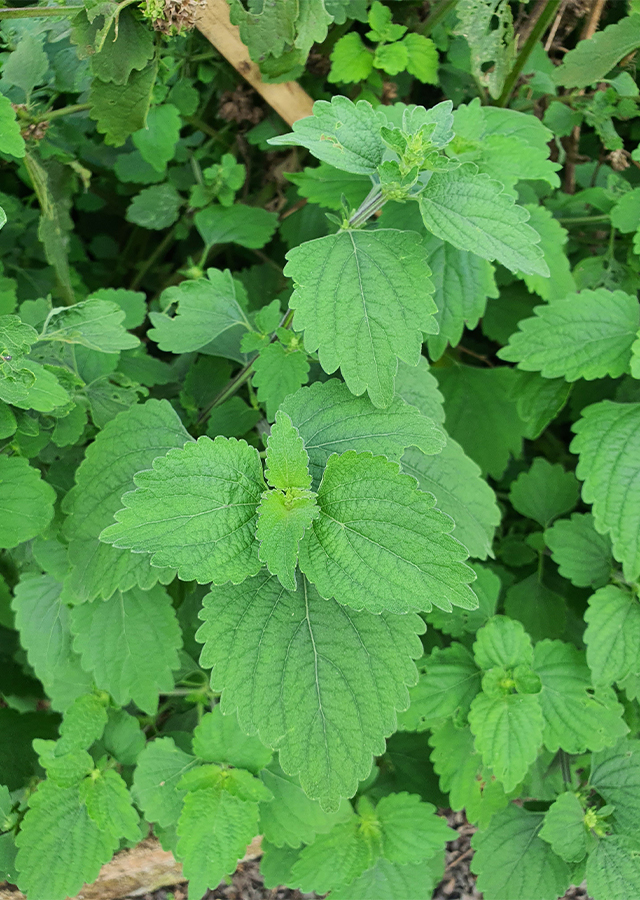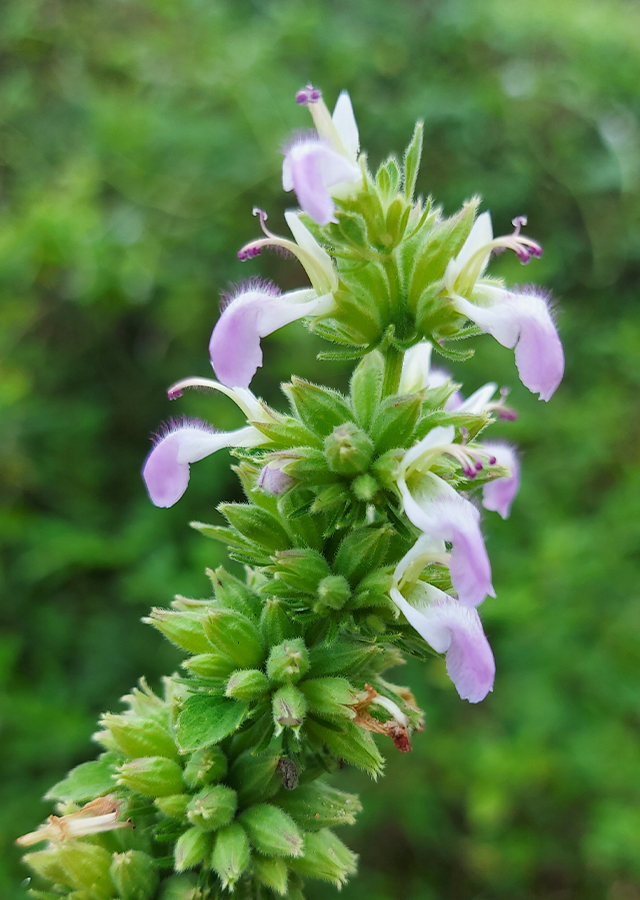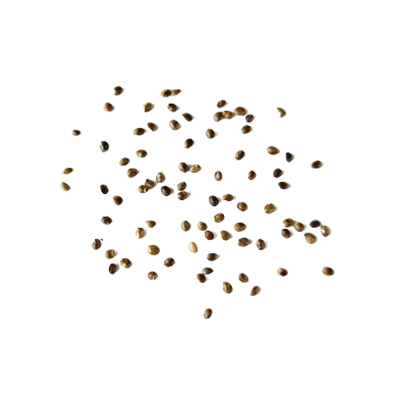Catmint
Anisomeles indica (L.) Kuntze
Lamiaceae
Location in our garden
Principal



Synonym
Ajuga disticha (L.) Roxb.
Anisomeles albiflora (Hassk.) Miq.
Epimeredi indicus (L.) Rothm.
Habitus
Herbaceous. A strongly aromatic, large, perennial herb growing up to 2 m tall
Part Used
Leaves
Seeds
Roots
Stem
The Whole Plant
Growing Requirements
Full Sunshine
Habitat
Riverbanks
Forest
Shrublands
Grassland
Overview
Catmint is native to South-East Asia, and is nowadays widely distributed from Africa, though not common there, through India, China, Japan and southwards from Malaysia to Australia. The plant is used as a medicinal herb, mainly gathered from the wild, and is also cultivated throughout its distribution area both as an ornamental and for the essential oil in its leaves.
Vernacular Names
Guang fang feng (Chinese), Kabling-parang (Tagalog-Philippines), Raato chaarapaate (Nepalese), Komko huai (Thailand) , Babadotan (Malaysia), Adabeera (India), San nga (Laos).
Agroecology
Catmint grows in sunny and open locations, grasslands, also in teak forests, and on wet soils along streams and irrigated rice fields, usually scattered, sometimes locally numerous, at elevations of 600-1,800 m. Hybridizes in the wild with Anisomeles malabarica.
Morphology
- Stems - erect, branched, sparsely hairy to densely hairy, quadrangular, more or less woody and persist.
- Leaves - thin, ovate 3-12 cm long, long-stalked and pointed at the tip with round-toothed margins, have a strong aromatic scent when crushed.
- Flowers - numerous, crowded and almost stalkless and occur in spikelike racemes 5 to 25 cm long and 2-3 cm in diameter. Calyx is about 6 mm long, corolla is purplish, 10-12 cm long, strongly zygomorphic, the upper lip being oblong-ovate and the lower lip have two middle lobes.
- Fruits - 9-10 mm long, greenish to whitish, and with dark red lines inside but sometimes purple or blue.
- Seeds - nutlets are subglobular, measuring 1.2 mm × 1 mm and shiny black.
Cultivation
- Propagation is done by seeds and stem cuttings.
- Plants flower throughout the year, when enough water is available.
Chemical Constituents
Triterpenoid (anisomelic acid), flavonoid, propanoid, β-sitosterol, stigmasterol, apigenin, ovatodiolides, essential oils (α-pinene, β-pinene, δ-limonene), isoacteoside.
Traditional Medicinal Uses
- The leaves and the roots are powerful astringent, carminative, febrifuge and tonic.
- Its essential oil which shows antimicrobial activity against Bacillus anthracis, Proteus vulgaris, Salmonella stanley, Salmonella newport, Streptococcus agalactiae, Staphylococcus aureus, Escherichia coli, Aspergillus fumigatus and Anisomeles niger.
- The plant is used in the treatment of rheumatism, colds, fevers, abdominal pain, skin sores, and snake bites. The whole dried plant have a cytotoxic action.
- In the Philippines, it is used for gastric catarrh and intermittent fevers.
- In the Dutch Indies, decoction of plant is used for urinary and kidney stones.
- In Sri Lanka, boiled stems and leaves are used for gastroprotection. Also, a decoction of leaves and stems is used to treat pain.
- In Chinese and Indian medicine, it is used to treat gastric dysfunction, inflammatory disorders, and hypertension.
- In Nepal and in Ayurveda, leaf extract is used for urinary complaints.
Part Used
Reference Sources
- Fern, Ken. (2014). Useful Tropical Plants. Anisomeles indica. http://tropical.theferns.info/viewtropical.ph.p?id=Anisomeles+indica. 30-01-2021.
- Globinmed. (2016). Anisomeles indica (L.) Kuntze. https://globinmed.com/index.php?option=com_content&view=article&id=105819:anisomeles-indica-l-kuntze&catid=286. 30-01-2021.
- StuartXchange. (2015). Philippine Medicinal Plants. Kabling-parang - Anisomeles indica (L.) Kuntze. http://www.stuartxchange.org/KablingParang. 30-01-2021.
- Baranwal, V.K., Irchhaiya, R., Singh, S. (2012). Anisomeles indica: An Overview. International Research Journal of Pharmacy 3(1): 84-87. https://www.researchgate.net/publication/284968207_Anisomeles_ indica_an_overview. 30-01-2021.



